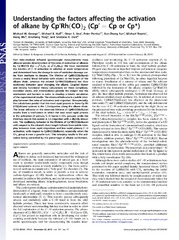Приказ основних података о документу
Understanding the factors affecting the activation of alkane by Cp ' Rh(CO)(2) (Cp ' = Cp or Cp*)
| dc.creator | George, Michael W. | |
| dc.creator | Hall, Michael B. | |
| dc.creator | Jina, Omar S. | |
| dc.creator | Portius, Peter | |
| dc.creator | Sun, Xue-Zhong | |
| dc.creator | Towrie, Michael | |
| dc.creator | Wu, Hong | |
| dc.creator | Yang, Xinzheng | |
| dc.creator | Zarić, Snežana D. | |
| dc.date.accessioned | 2018-11-22T00:17:19Z | |
| dc.date.available | 2018-11-22T00:17:19Z | |
| dc.date.issued | 2010 | |
| dc.identifier.issn | 0027-8424 | |
| dc.identifier.uri | https://cherry.chem.bg.ac.rs/handle/123456789/1136 | |
| dc.description.abstract | Fast time-resolved infrared spectroscopic measurements have allowed precise determination of the rates of activation of alkanes by Cp'Rh(CO) (Cp' = eta(5)-C5H5 or eta(5)-C5Me5). We have monitored the kinetics of C-H activation in solution at room temperature and determined how the change in rate of oxidative cleavage varies from methane to decane. The lifetime of CpRh(CO)(alkane) shows a nearly linear behavior with respect to the length of the alkane chain, whereas the related Cp*Rh(CO)(alkane) has clear oscillatory behavior upon changing the alkane. Coupled cluster and density functional theory calculations on these complexes, transition states, and intermediates provide the insight into the mechanism and barriers in order to develop a kinetic simulation of the experimental results. The observed behavior is a subtle interplay between the rates of activation and migration. Unexpectedly, the calculations predict that the most rapid process in these Cp'Rh (CO)(alkane) systems is the 1,3-migration along the alkane chain. The linear behavior in the observed lifetime of CpRh(CO)(alkane) results from a mechanism in which the next most rapid process is the activation of primary C-H bonds (-CH3 groups), while the third key step in this system is 1,2-migration with a slightly slower rate. The oscillatory behavior in the lifetime of Cp*Rh(CO)(alkane) with respect to the alkane's chain length follows from subtle interplay between more rapid migrations and less rapid primary C-H activation, with respect to CpRh(CO)(alkane), especially when the CH3 group is near a gauche turn. This interplay results in the activation being controlled by the percentage of alkane conformers. | en |
| dc.publisher | Natl Acad Sciences, Washington | |
| dc.relation | info:eu-repo/grantAgreement/MESTD/MPN2006-2010/142037/RS// | |
| dc.relation | European Union, FP6-502440 | |
| dc.relation | Welch Foundation [A-0648] | |
| dc.relation | National Science Foundation [CHE-0910552, CHE-0518074, CHE-0541587, DMS-0216275] | |
| dc.relation | Wolfson Merit Award | |
| dc.relation | Engineering and Physical Sciences Research Council | |
| dc.rights | openAccess | |
| dc.rights.uri | https://creativecommons.org/licenses/by-nc-nd/4.0/ | |
| dc.source | Proceedings of the National Academy of Sciences of the United States | |
| dc.subject | organometallic | en |
| dc.subject | photochemistry | en |
| dc.subject | computation | en |
| dc.subject | transition metal | en |
| dc.subject | sigma complex | en |
| dc.title | Understanding the factors affecting the activation of alkane by Cp ' Rh(CO)(2) (Cp ' = Cp or Cp*) | en |
| dc.type | article | |
| dc.rights.license | BY-NC-ND | |
| dcterms.abstract | Портиус, Петер; Wу, Хонг; Јина, Омар С.; Сун, Xуе-Зхонг; Тоwрие, Мицхаел; Халл, Мицхаел Б.; Yанг, Xинзхенг; Зарић, Снежана; Георге, Мицхаел W.; | |
| dc.citation.volume | 107 | |
| dc.citation.issue | 47 | |
| dc.citation.spage | 20178 | |
| dc.citation.epage | 20183 | |
| dc.identifier.wos | 000284529000010 | |
| dc.identifier.doi | 10.1073/pnas.1001249107 | |
| dc.citation.other | 107(47): 20178-20183 | |
| dc.citation.rank | aM21 | |
| dc.identifier.pmid | 21048088 | |
| dc.type.version | publishedVersion | |
| dc.identifier.scopus | 2-s2.0-78650585987 | |
| dc.identifier.fulltext | https://cherry.chem.bg.ac.rs/bitstream/id/8333/1134.pdf |


